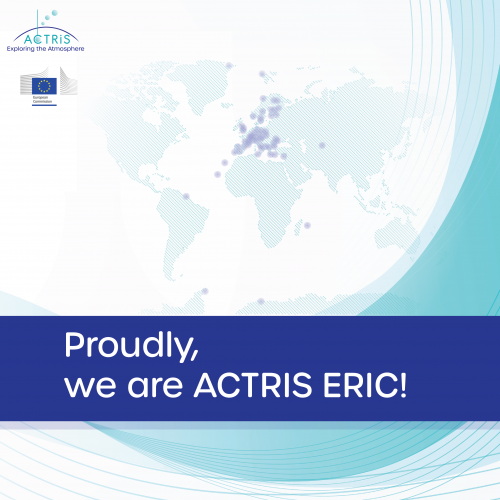National Facilities


edited on: 03.05.2023
The European Commission has taken a long-anticipated decision to establish the Aerosol, Clouds, and Trace Gases Research Infrastructure (ACTRIS) as a European Research Infrastructure Consortium, or ERIC. The implementing decision is publicly available in the EU Official Journal (link).
ACTRIS ERIC provides access to a large variety of high-quality services to a wide range of users and needs, for scientific, technological, and innovation-oriented usage through its internationally recognized National Facilities. ACTRIS National Facilities are distributed across ACTRIS ERIC’s 17 countries: Austria, Belgium, Bulgaria, Cyprus, Czechia, Denmark, Finland, France, Germany, Italy, Netherlands, Norway, Poland, Romania, Spain, Sweden, and Switzerland. Greece and UK expressed interest in joining at later stages. With their commitment, the members demonstrate atmospheric and air quality research as a national priority for at least the next five years, thereby supporting scientific excellence across Europe. Being a member country of ACTRIS ERIC means that a country’s representative can help shape the strategy, participate in mission-based research, and join ACTRIS's unified voice at the forefront of European science and education landscape of atmospheric research focused on aerosol, clouds, and trace gases. ACTRIS facilities make up the largest, multi-site atmospheric research infrastructure in the world and offer its users open access to instruments, expertise, training opportunities, and data management services. All users, regardless of their affiliation, area of expertise, or field of activity, can benefit from ACTRIS pan-European open-access services. ACTRIS aims at increasing the excellence in Earth system observation and research by providing information and knowledge for developing sustainable solutions to societal needs.
With its ERIC status, ACTRIS is now legally recognized as a European Research Infrastructure providing ACTRIS with a stable legal structure. The establishment of ACTRIC ERIC manifests the fast progress of ACTRIS from a project-based network to a mature and sustainable research infrastructure. Finland will host the Statutory Seat and manage the overall coordination of ACTRIS and Italy will manage the access to ACTRIS services. “This decision means the ACTRIS facilities can now operate legally together, as one organisation,” says Eija Juurola, Interim ACTRIS Leader. “The decision comes at an important time since the transition to operations is already happening, and the synergies with scientists and industry are continuously developing.”
ACTRIS entered its journey towards ACTRIS-ERIC as early as 2011, achieving important scientific and technical milestones that led to a deeper understanding of the driving forces of climate change and air pollution. Monitoring the spatial and temporal variability of short-lived atmospheric constituents (aerosol, clouds, and trace gases) from 80 observation platforms in Europe and beyond over more than a decade provided unprecedented views of the effectiveness of emission reduction policies in Europe but also highlighted the complex feedback mechanisms acting on the climate system. Hundreds of researchers Worldwide but also users from the private sector accessed the ACTRIS platforms (observation site, atmospheric simulation chambers) to perform novel experiments improving scientific knowledge, develop new instruments, or got trained on new technologies. Every year, over 5000 users distributed around 50 countries in the World use the ACTRIS data for their research, enabling reliable atmospheric predictions, including short-term hazardous weather and health warnings as well as long-term evaluation of climate change.
ACTRIS core components are the National facilities, constituting observatory and exploratory platforms, and the Central Facilities, fundamental for the provision of harmonized high-quality data, both within Europe and at selected global sites providing users with access to state-of-the-art, well-characterized and versatile facilities. The scientists coming to ACTRIS will be able to do multidisciplinary studies relevant to both fundamental and applied research. That will lead to broad benefits to society ranging from building effective environmental policies and strategies to reduce the emission of pollutants, which mitigate climate change and improve air quality helping to reach the EU Green Deal’s objectives.
ACTRIS is a large research infrastructure with substantial financial volume and its operations are funded by its member countries. The total investment by the participating countries during the design, preparatory, and implementation phase is approximately 700 M€, of which a large part is an investment for upgrading the existing national facilities or building new ones. “Thanks to concentrated international cooperation, in just ten years we have been able to build and make operational state-of-the-art scientific instruments that open up unprecedented opportunities for breakthrough discoveries,” says Paolo Laj, Interim ACTRIS Scientific Chair. “ACTRIS is consolidating its position in the national, European, and international landscapes, expanding its role as a key player supporting environmental research. Quality of services, open innovation culture, and agility to respond to demand from user communities will enhance the level of trust, integrity, and confidence between ACTRIS and its partners.”
ACTRIS, together with other European environmental research infrastructures, contribute to the new European Research Area (ERA) objectives with larger R&D investments, more evenly distributed capacities and access to excellent R&I in atmospheric research across Europe, better circulation of knowledge and technology, and finally increased EU competitiveness.
Find more:
Contacts:
Eija Juurola, Interim ACTRIS Leader: eija.juurola@fmi.fi
Paolo Laj, ACTRIS Scientific Chair: paolo.laj@univ-grenoble-alpes.fr












